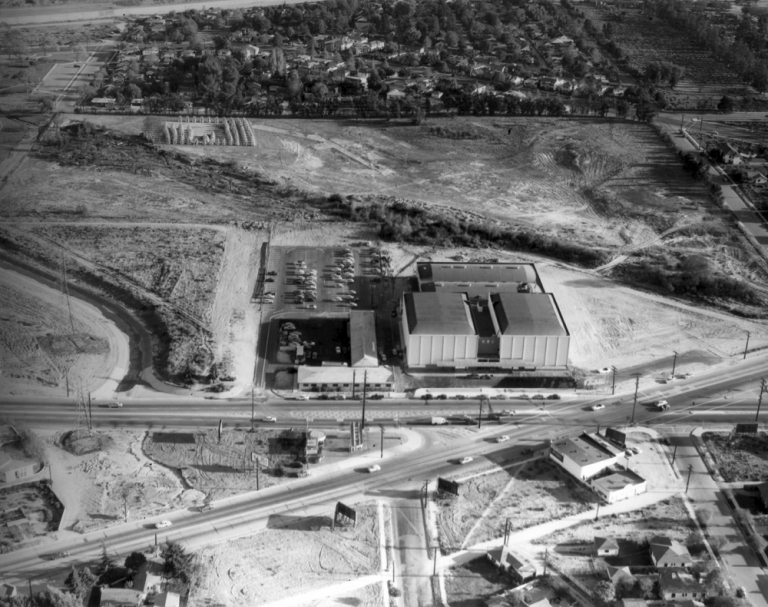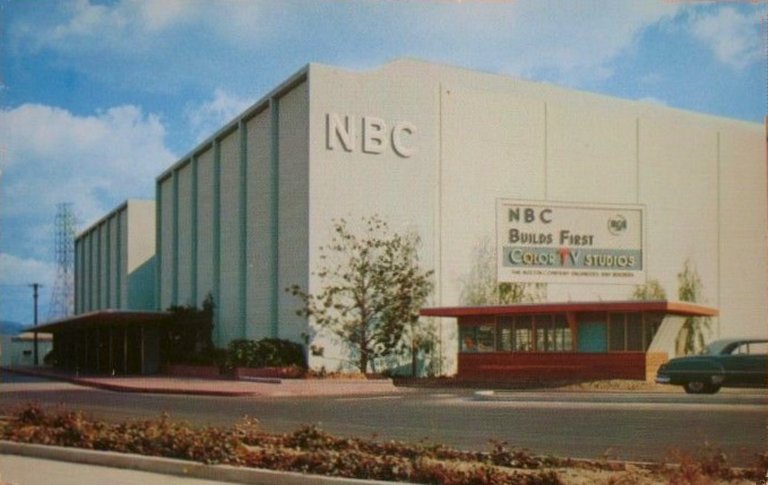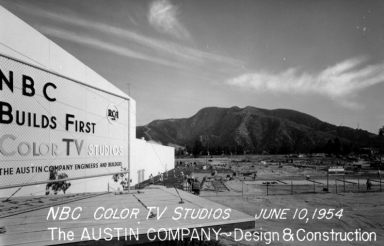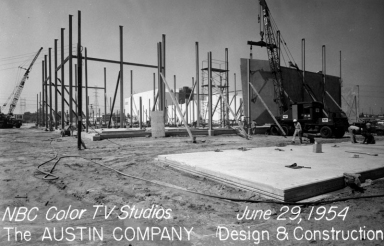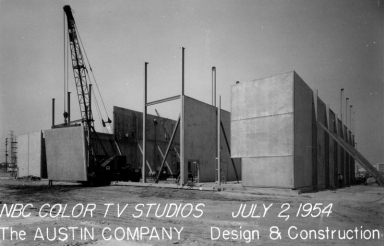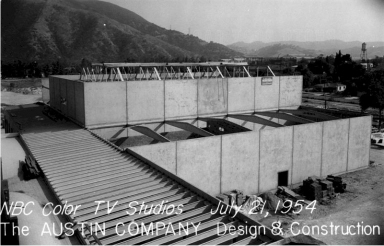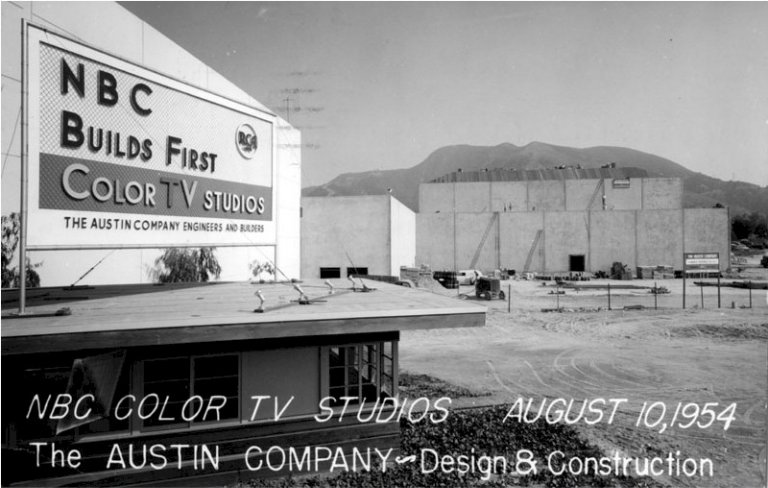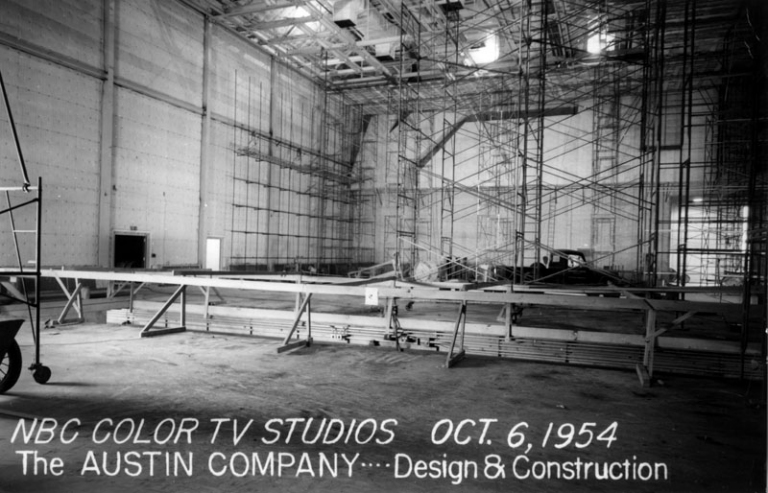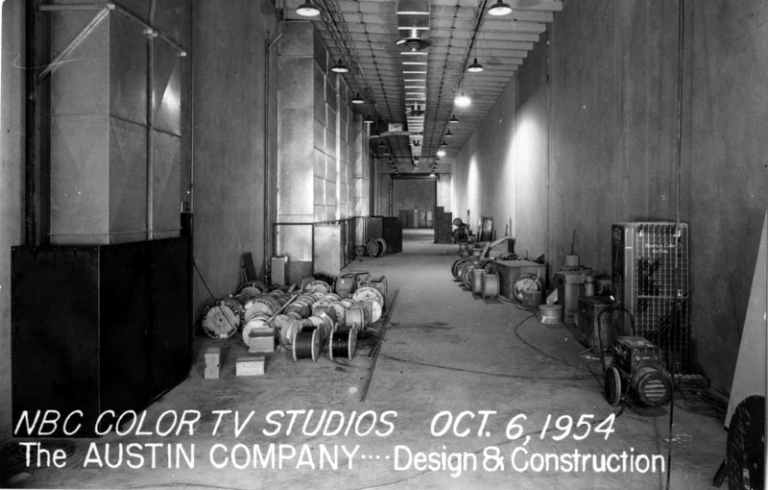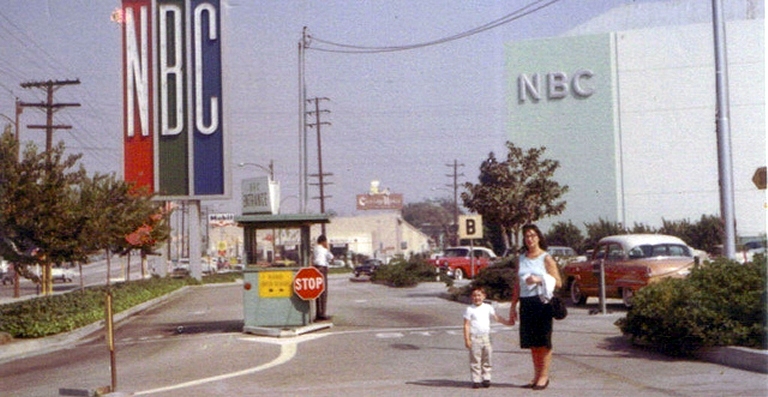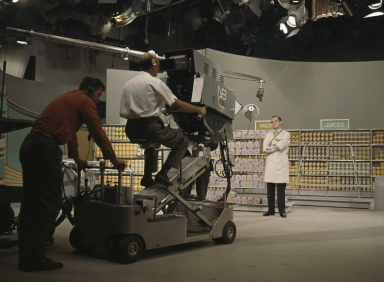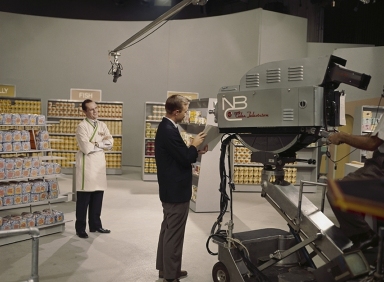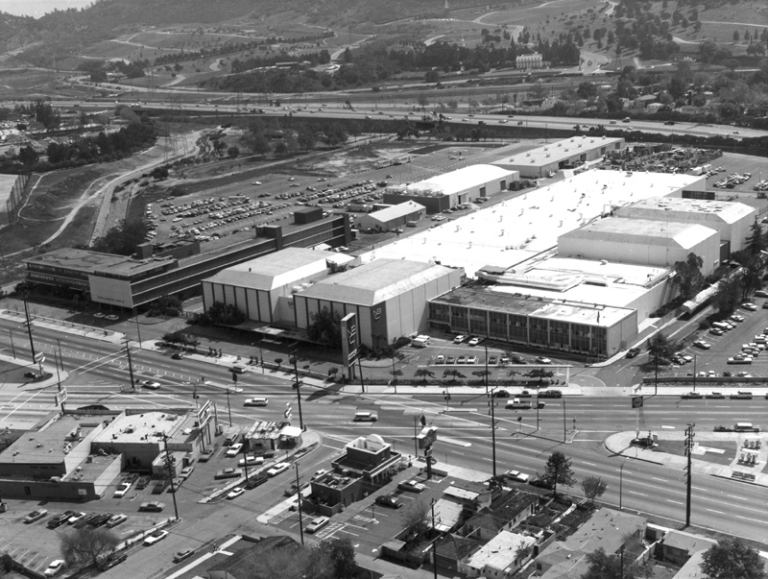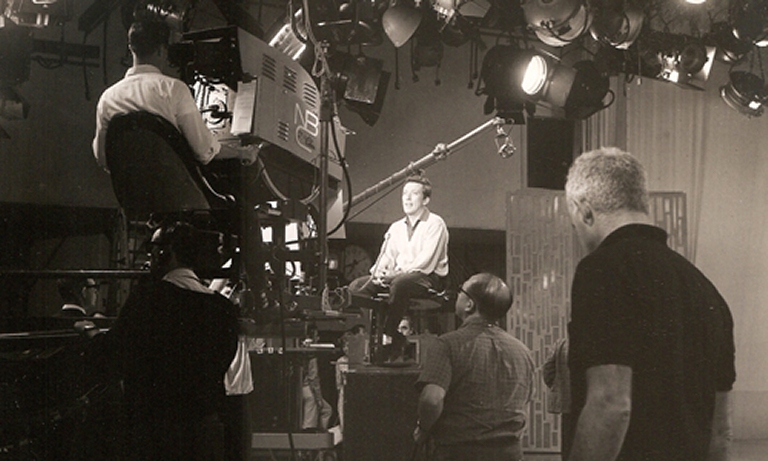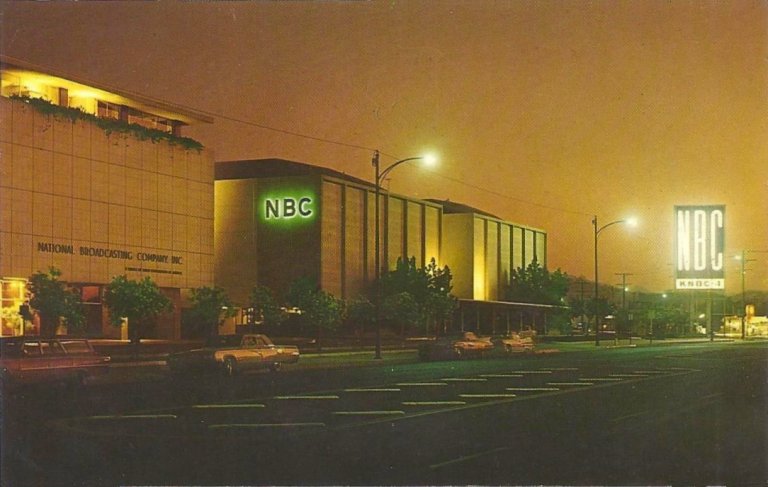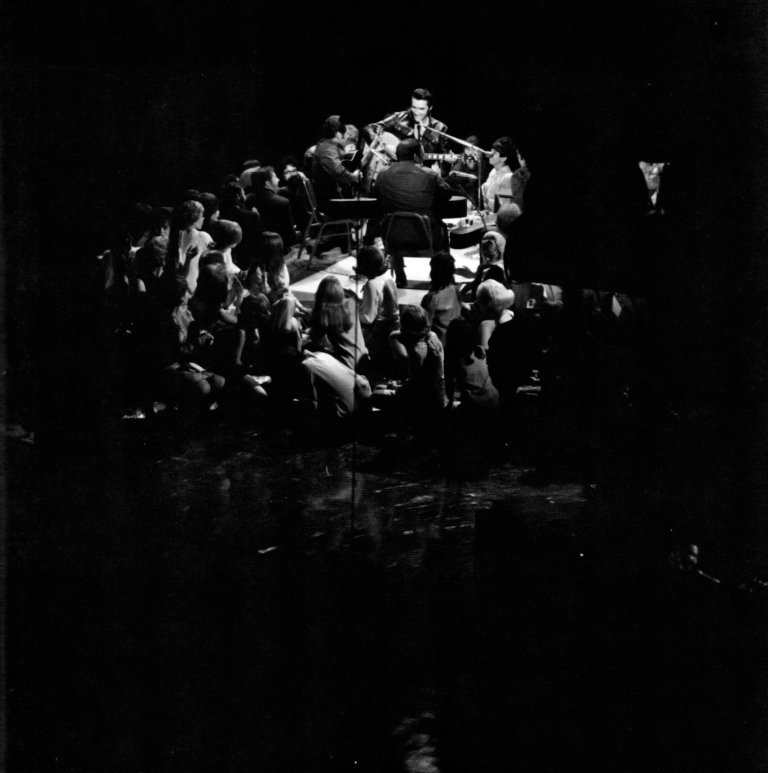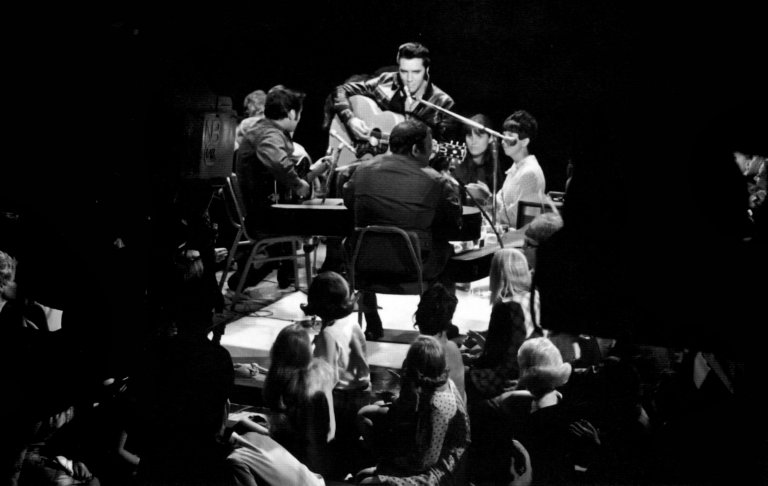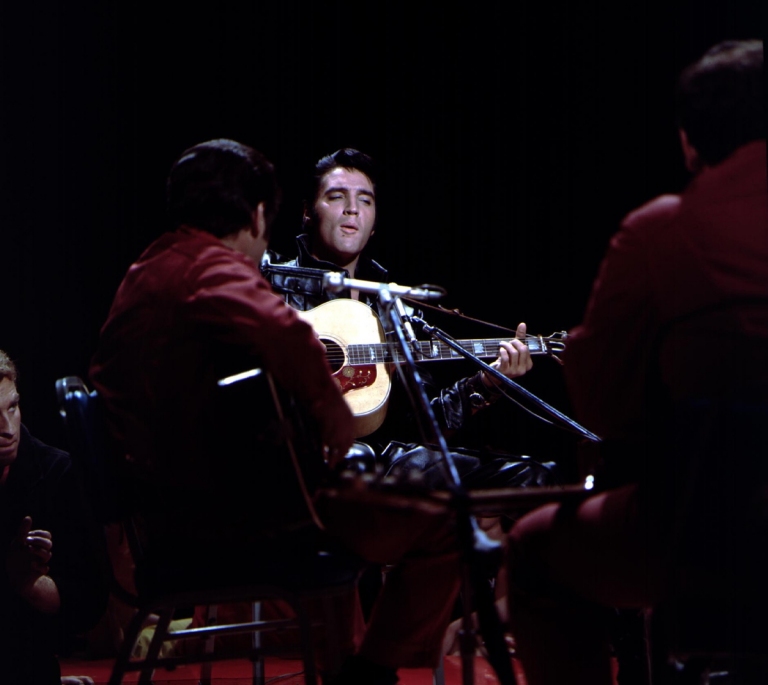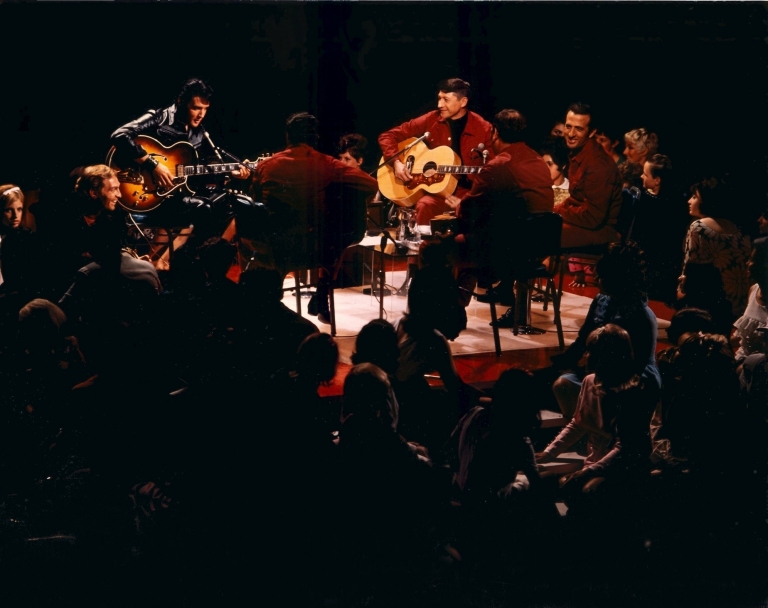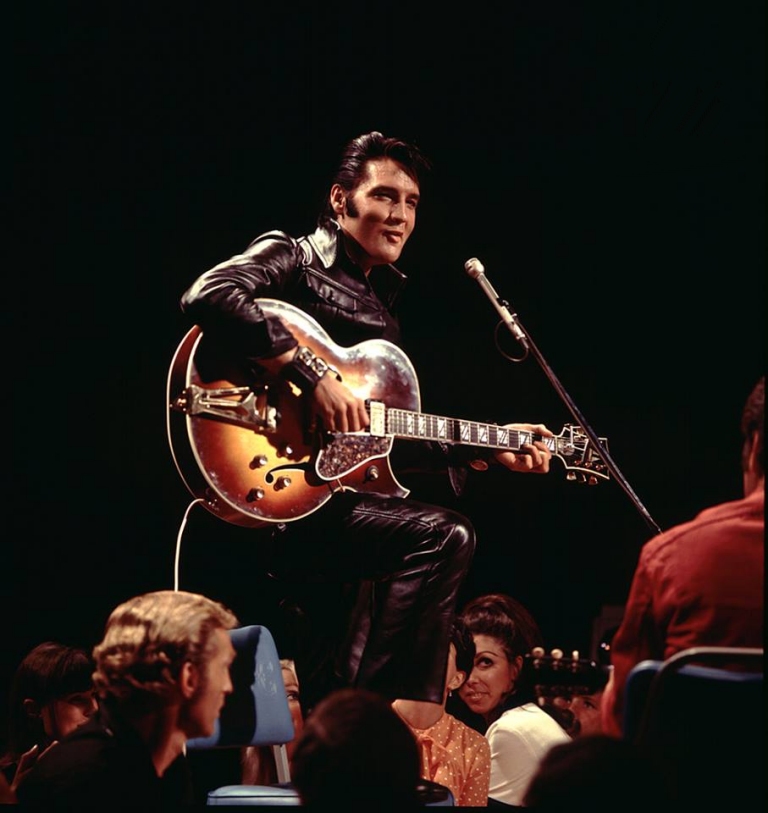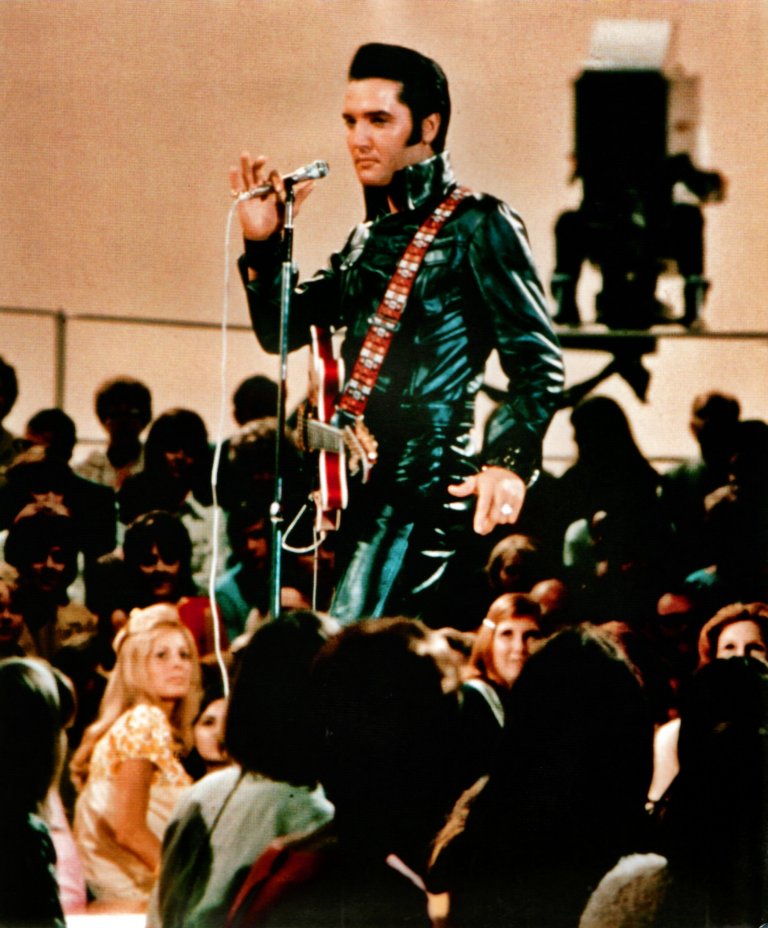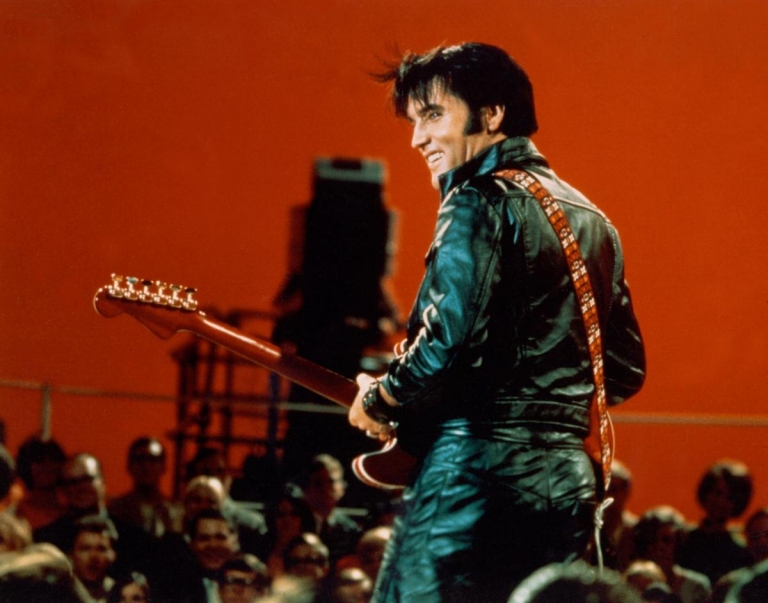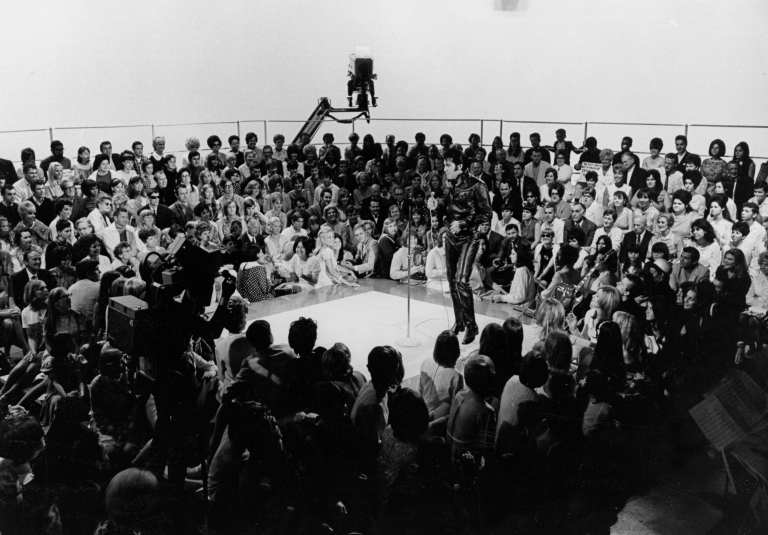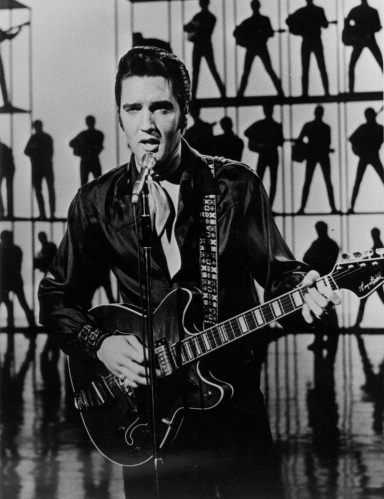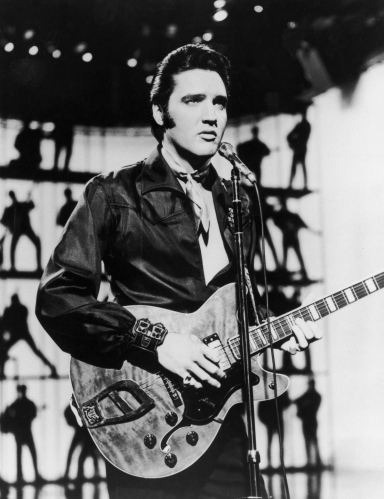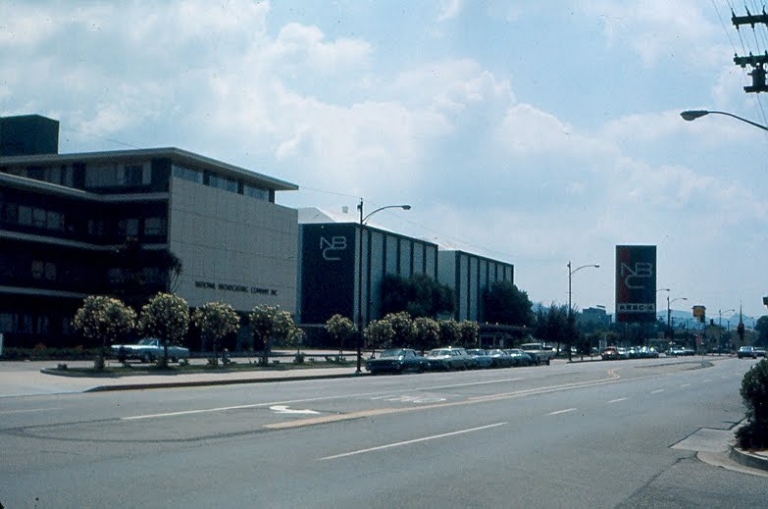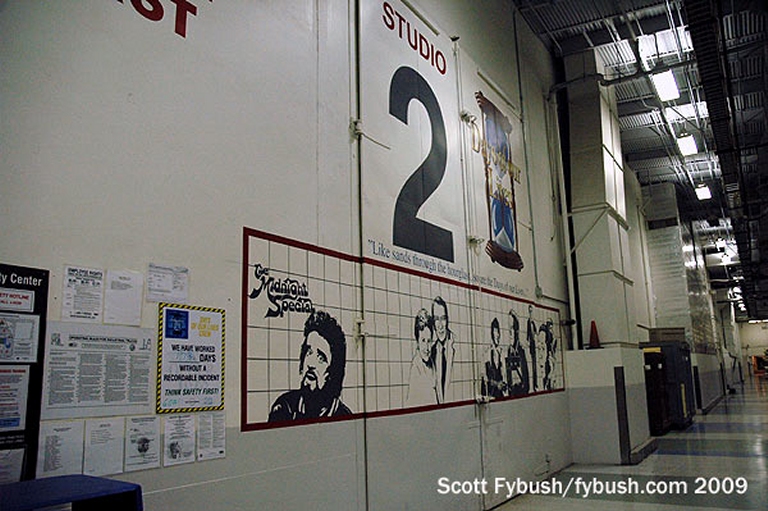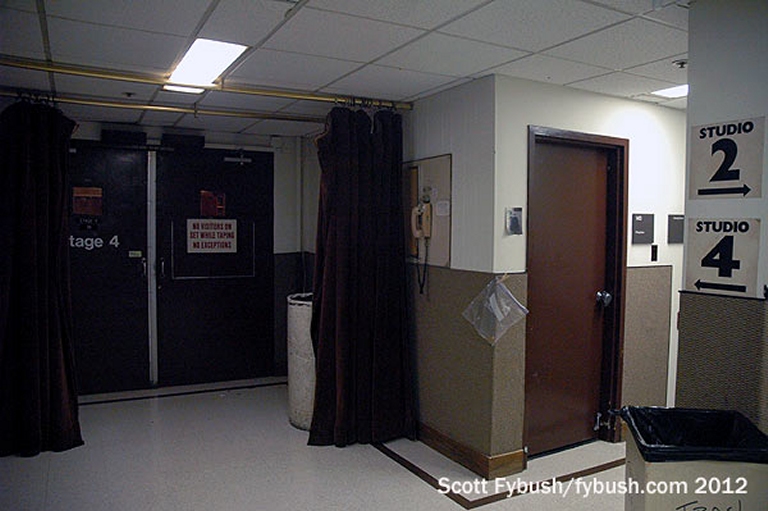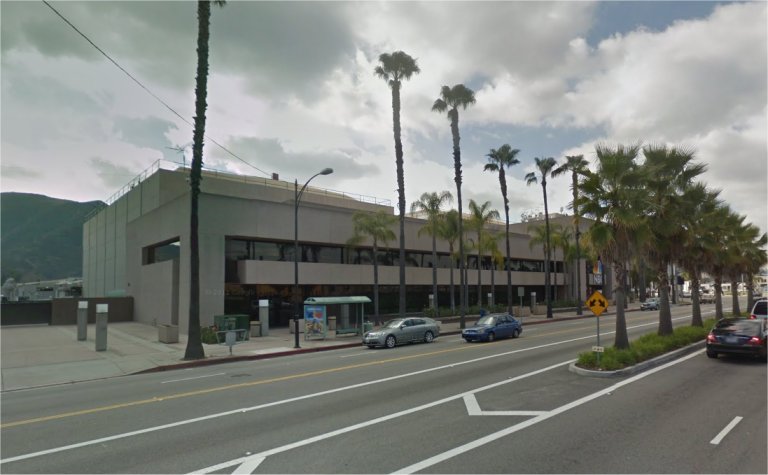 |
NBC Studios
In June of 1956 Elvis, Scotty, Bill and DJ made their second appearance on the Milton Berle Show, only this time at NBC’s original West Coast facility in Hollywood. It was located at the corner of Sunset and Vine across the street from Wallich’s Music City. Designed by John C. Austin in 1938, it was initially built for radio and called Radio City but by 1949 the radio studios were equipped for live television broadcasting.1
As the production and popularity of television increased the facilities at Radio City became too small for NBC’s operations prompting its parent company, RCA, to build a television studio from the ground up. In 1951 they purchased 19 acres of land in the San Fernando Valley from the city of Burbank and 30 acres from Jack Warner. It was originally an old riverbed wash and part of Warner Brothers Studio's exterior backlot, though used infrequently. Nicknamed NBC Color City, it was the first major color television studio in the country to be built from the ground up.1&2
A few black-and-white programs were broadcast from the facility when the first phase was completed in September of 1952 but the FCC didn’t approve the final standard of compatible NTSC until December 1953. In April of 1954 construction began on the third stage to be built at Burbank, Studio 2, which NBC promoted as the “first studio to be built exclusively for color broadcasting." A new technical operations building was also part of this phase of the construction and the Color City label came to refer to the whole operation even though the network continued to originate black and white programs from the first two studios for several years. The facility was officially dedicated on March 27, 1955 and its premier production was a 90 minute color spectacular entitled “Entertainment, 1955.” 2
Not long after NBC announced plans to build Studio 4 in time for the 1956 television season. It was identical to Studio 2. At 139 feet long, 89 feet wide and 42 feet, the two soundstages utilized movable audience bleachers maintaining an expansive 12,371 square foot studio stage area with a full 360 degree sharks tooth and bleached muslin cyclorama. They were primarily reserved for color specials, and later for music and variety series television productions such as Milton Berle, Jerry Lewis, Dean Martin, Eddie Fisher, Dinah Shore, Andy Williams, Wheel of Fortune, Bing Crosby, Frank Sinatra, Mitzi Gaynor, Danny Kaye, Fun Factory, Days of Our Lives, Lux Video Theatre, Bright Promise, Return to Peyton Place and others.1&3
In November 1962 KNBC moved to the new facility from the Sunset and Vine location in Hollywood changing its call letters from KRCA in the process and the Hollywood property was sold and demolished by 1964. RCA-NBC did however purchase property one block west of there to keep its FCA license intact and to use as recording studios and offices.1
In 1961 there were talks to record and broadcast the USS Arizona Memorial Benefit concert in Hawaii on NBC and as early as 1965 Colonel Parker had been negotiating with NBC’s Tom Sarnoff to finance and premier a motion picture with Elvis domestically. In October of 1967 the Colonel proposed to Sarnoff the idea for a Christmas special which would be Elvis’ first television appearance since Sinatra’s Welcome Home Elvis special in 1960. According to Peter Guralnick, Elvis, by now growing discontent, was not happy about singing a bunch of Christmas Carols on national TV and viewed it as just a scheme to get another Christmas album.4
Bob Finkel was the executive producer who had put the NBC package together which was sponsored by the Singer sewing company, and who ultimately had swayed the sponsor, network and the Colonel from the idea of simply putting Elvis on a stage to sing Christmas songs for an hour. The stipulation was however that it essentially be a “one-man show” (no other contemporaries) and RCA get a soundtrack and Christmas single out of it. Meeting with Elvis in May of 1968 he realized that Elvis wanted this show to depart completely from the pattern of his motion pictures and from everything else he has done, wanted everyone to know what he could do and was not interested in what Colonel Parker had to say about this show. Finkel decided on Steve Binder and his partner Bones Howe as producers. Binder was reluctant at first but Howe who had worked with Elvis previously at Radio Recorders in the ‘50s believed it to be a good match.4
Meeting with the Colonel they were told that they could submit any material for the show as long as “Elvis” approved of it but, as usual, they ultimately must have the publishing rights. Production moved into NBC on June 17th and Scotty and D.J. flew in the following weekend, five days before filming in Studio 4 was scheduled to start. The idea was to prerecord everything except the two live performances (the Concert and the informal segment with Scotty and DJ). Recording started up on the evening of the twentieth at Western Recorders at 6000 Sunset Blvd. with a band that Bones Howe had put together of many of the top L.A. Session musicians, including Al Casey whose red Hagstrom guitar would be noticed by Binder and then used by Elvis in segments of the show.4 While in town, Scotty and DJ had gone to dinner at Elvis' house after which he pulled them aside. Scotty thought it was unusual that Elvis wanted to talk to them in private. He usually felt free to talk in front of his bodyguards. When they were alone, Elvis asked if they would be interested in doing a European tour with him. Scotty and D. J. both said they would love to do it.5
“He had talked about it when he got out of the Army, but he hadn’t mentioned it again since then,” says Scotty. “He turned to me and asked if l still had the studio in Nashville. I said, yeah, and if we are going to do the European tour let me know ahead of time so I can get someone to fill in for me. He asked me what would be the chances of us going into the studio and just locking the doors for a couple of weeks to see what we could come up with. I told him sure, to just let me know when. He didn’t say what was on his mind. I know he was tired of the movie songs. He might have wanted to go back to where we were in the early years. Knowing his mindset at that point in time, it gave me renewed hope. He just wanted to try something without somebody saying, ‘That song fits this scene in the movie.’" 5
After watching Elvis unwind each day in his dressing room laughing and joking with the guys and guitars Binder decided on the format of the informal sit down sessions of the show. He felt that unscripted Elvis would be most comfortable with Scotty, DJ and the others performing jam-like in the round with only a loose list of topics from the director to talk about. Essentially just winging it.4 On stage were Elvis with his 1960 J200, and entourage members Charlie Hodge with his Gibson L4 and Alan Fortas with a classical guitar prop used in the special and/or a case both of which he basically just kept on his lap. DJ played percussion on an empty guitar case and Scotty was the only one onstage with an electric guitar, his 1963 Super 400.
Since they were told they'd be sitting Scotty said he didn't put straps on his or Elvis' acoustic.4 "Scotty was playing lead for a while and all of a sudden Elvis wanted to play lead,” says D. J. Fontana. “So he goes over and grabs Scotty’s guitar.” D. J. was horrified. He knew how meticulous Scotty was about his guitar. “I thought, ‘What are we going to do here.’ Scotty wasn’t very happy about that. Elvis was a flogger and I knew he was afraid he’d scar up the guitar. lt worked out, but oh boy, he doesn’t like anyone to touch that guitar." 5 Elvis played Scotty’s guitar for the remainder of the show. During the show(s), Elvis decided to stand to play, adlibbing lyrics about having "no strap" to the tune of One Night.
Scotty and DJ’s segments with Elvis were two shows performed on June 27th at Studio 4 at 6:00 p.m. and 8:00 p.m. According to Guralnick, Binder said that distribution of tickets was left to the Colonel though early on NBC had announced an upcoming special in TV Guide and some fans had requested and received tickets through the mail. Only about 50 of these were rumored to have been given out though and according to Binder there was a last minute scramble to find people to attend. As in the '50s, the Colonel then proceeded to bring the most adoring female fans there to the front hoping to replicate the kind of responses witnessed while touring in the ‘50s.4
On the 29th, Elvis performed two more shows, himself alone onstage, to a live audience. Parts from each of these segments were later mixed with the other production numbers used for the special and which basically was a review of his career to date through performing and the movies all set to the theme of the song “Guitar Man.”
The show aired on December 3rd and Jon Landau, in his review of Beggars Banquet by the Rolling Stones for Rolling Stone magazine only days later, made the observation, An example of someone who doesn't change is Elvis Presley. His recent TV special was a testimony to the vitality of his original style. How many rock stars of today might be able, ten years from now, to do an hour of the songs of 1968 and make it come alive as a contemporary experience? Presley at his best is about as eternal as rock and roll can ever expect to be.6
Landau's observations though were short lived and change was right around the corner. The European tour obviously never happened, and likewise neither did they ever lock themselves away in Scotty’s studio. In fact recording the special that June was the last time that Scotty and Elvis ever saw each other.
Motivated by its success Elvis returned to Memphis to record a new album, outside of the norm and routine production and material that had become stagnant. At American Sound Chips Moman had a proven hit making team and was not going to change. In 1969 with his movie commitments all but up Elvis returned to live performing, but he did so with a new band and Scotty decided to hang up his guitar and focus on his studio and engineering.
The Burbank studios would host many of the best-remembered game and variety shows through the 1990s. In 1972 Johnny Carson moved The Tonight Show to NBC's Burbank Studios from New York where it stayed until 2009 when his successor, Jay Leno, was briefly replaced by Conan O’Brien. It returned when Jay did. After NBC changed ownership several times, most recently NBC-Universal, GE and currently Comcast, plans were announced in 2007 to move operations to new facilities in Universal City and the Burbank complex was sold the following year to The Catalina/Worthe Real Estate Group. However, space was leased at the Burbank site until May of 2013.7
In 1989, Studios 2 and 4 became the permanent home of the daytime soap opera, “Days of Our Lives,” which had earlier been produced at the back of the lot in Studio 9.8 When Jay Leno ultimately retired in 2014 his replacement, Jimmy Fallon, took the Tonight Show back to New York. The last nationally televised show to be broadcast from the NBC Burbank Studios was the MSNBC show on March 13th, 2014.1 The facility is now called The Burbank Studios.
page added April 10, 2014
1 according to wikipedia:
The Burbank Studios
|
| All photos on this site (that we didn't borrow) unless otherwise indicated are the property of either Scotty Moore or James V. Roy and unauthorized use or reproduction is prohibited. |

